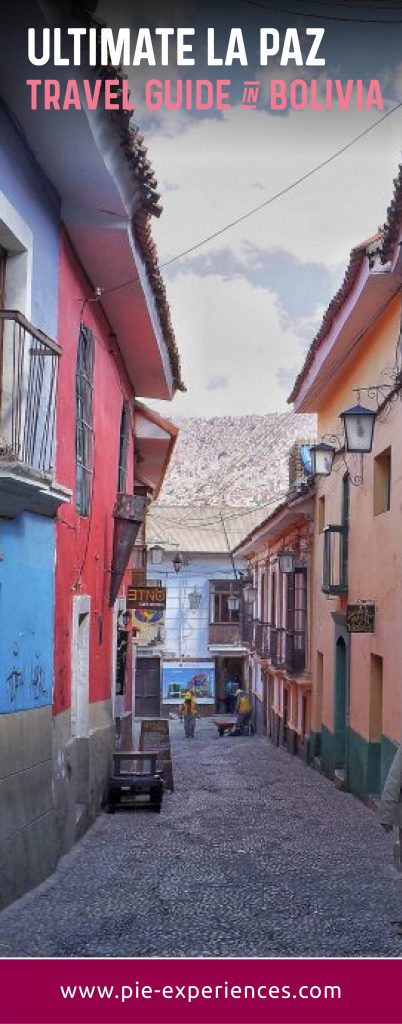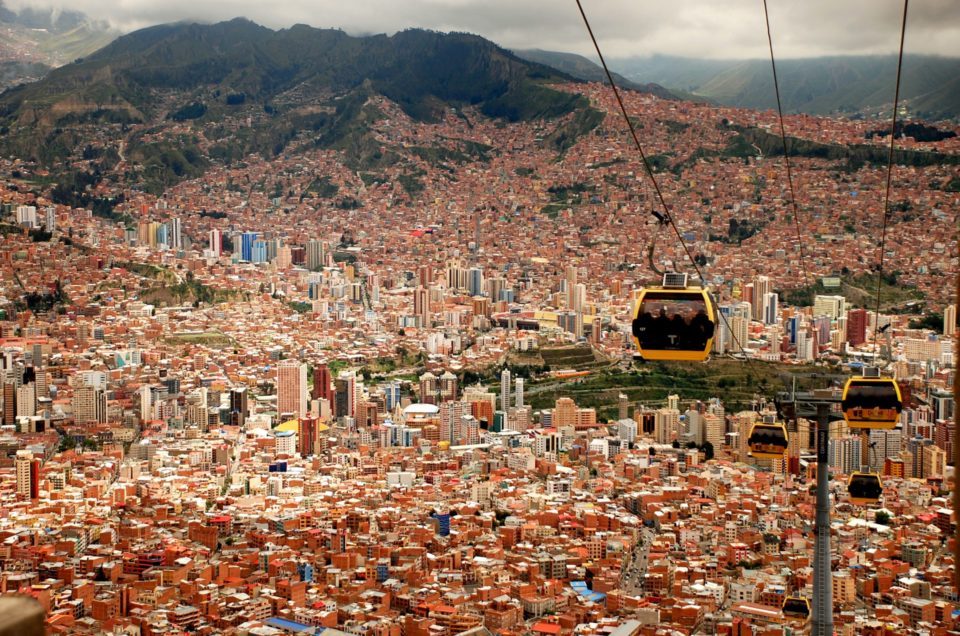Welcome to our La Paz travel guide, your inside look at one of Latin America’s most vibrant and high-altitude capitals.
Nestled in a steep canyon and surrounded by the towering peaks of the Altiplano, La Paz offers a dramatic blend of urban energy and natural grandeur. This is where Bolivia’s rich cultural layers meet — Indigenous traditions, colonial history, and modern life all packed into one chaotic, colorful city.
From cable cars gliding above sprawling neighborhoods to buzzing markets, sacred mountains, and street food that surprises you in the best way — La Paz is a must-visit for anyone traveling through Bolivia.
In this guide, we’ll cover everything you need to know: what to see, where to go, how to get around, and how to make the most of your time in this unforgettable city.
Quick Summary – La Paz Travel Guide 2026
-
📍 Location: La Paz is Bolivia’s high-altitude capital, nestled in a deep Andean valley at over 3,600 meters (11,800 ft).
-
🚠 Must-do: Ride the Mi Teleférico cable cars — the world’s highest urban transit system — for panoramic views across the city.
-
🧭 Top attractions: Witches’ Market, Valley of the Moon, San Francisco Church, street food, and day trips to Death Road.
-
🍽️ What to eat: Salteñas, anticuchos, api with pastel, and fresh market lunches.
-
🧳 What to pack: Layers for changing weather, sun protection, coca candies, and altitude meds.
-
💡 Travel tip: Take it slow the first 24–48 hours — altitude sickness is real, even for seasoned travelers.
La Paz Travel Guide – Essentials
With its elevated position on Bolivia’s high plains La Paz is the highest capital in the world at 3640 metres (11,900 feet).
La Paz Travel Guide Tip:
Visitors flying right into La Paz should be sure to take time to acclimatise to the altitude.
Stay hydrated, take it slow and don’t attempt too much, avoid alcohol and get plenty of sleep.
As a result you can enjoy all that La Paz has to offer, in full health.
Due to the altitude, the temperatures don’t tend to make it above 14C even in the summer between December and March.
In winter the temperatures drop a little lower, but it is still sunny.
In addition, the sun is strong during the day and the nights can be bitterly cold.
Don’t forget your warm clothes and layer up when out and about.
So, your La Paz packing list should include a potent mix of sunglasses, suncream, woolly hat and thermals!
A massive metropolis, La Paz can be almost overwhelming to navigate at times.
The three main areas to remember are El Prado: the town centre, Sopocachi: a bohemian suburb and Zona Sur, the affluent southern part of the city.
How to get to La Paz
By Air: The airport that serves the city is actually in neighbouring El Alto.
Since it is perched high above La Paz, El Alto (which translates as The Heights) lives up to its name.
Flights come from many major international destinations, much as national ones.
By Road: The main bus terminal in La Paz offers many national and international destinations, making La Paz a great starting point for your Bolivian adventures.
Direct buses run from Chile, Peru and Argentina.
The port of Copacabana on Lake Titicaca and the ruins of Tiwanaku are also a short hop away.
Hence, when travelling by car it’s noteworthy that the highway from La Paz to the Lake, is one of the best in a country.
La Paz Travel Guide – What to do
Let Plaza San Francisco Welcome You to the Heart of La Paz
First of all, go to this majestic square dominated by the huge San Francisco Basilica.
This plaza is the perfect vantage point for people-watching.
Always filled with people, from locals going about their daily life, vendors selling their wares and street performers entertaining crowds.
Furthermore, it’s easy to explore the old Aymara neighbourhoods and Calle Sagarnaga, a shopping street, from here.
Enjoy the Best Views of La Paz from the Air
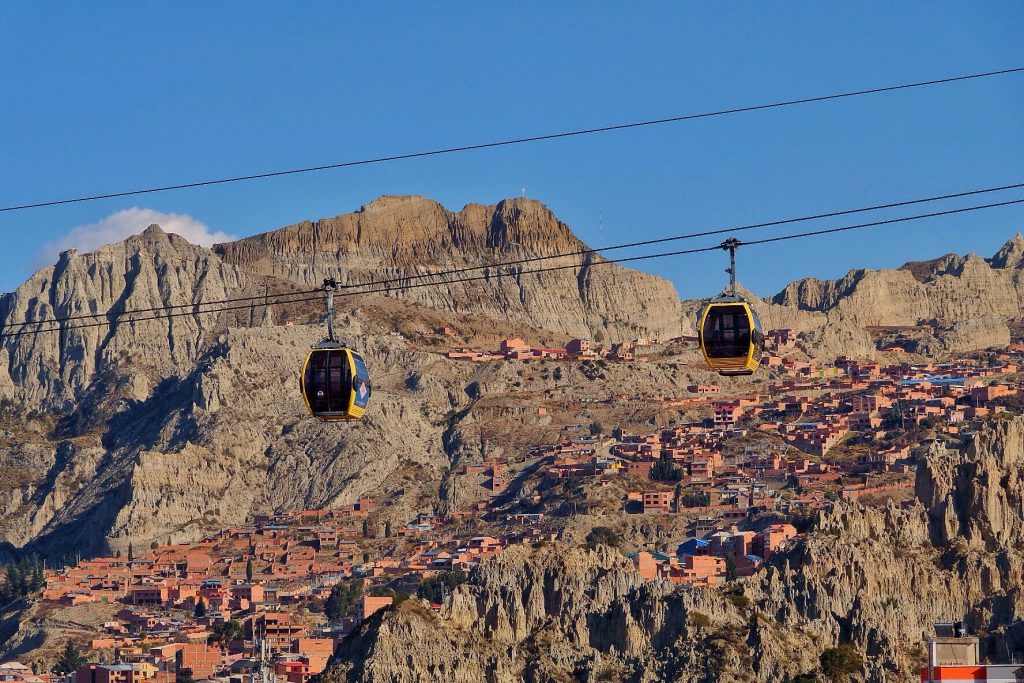
Yellow line of the Mi Teleférico. Picture by Giacomo Russo.
There is no better way to get around whilst seeing breathtaking, unobstructed views of La Paz, than hitching a ride on the Mi Teleferico.
These modern cable cars connect El Alto with La Paz and swoop almost noiselessly over the vast carpet of buildings.
The network is extensive and expanding all the time, so put your vertigo aside and enjoy a real treat.
Enjoy the tranquility of Mirador del Montículo
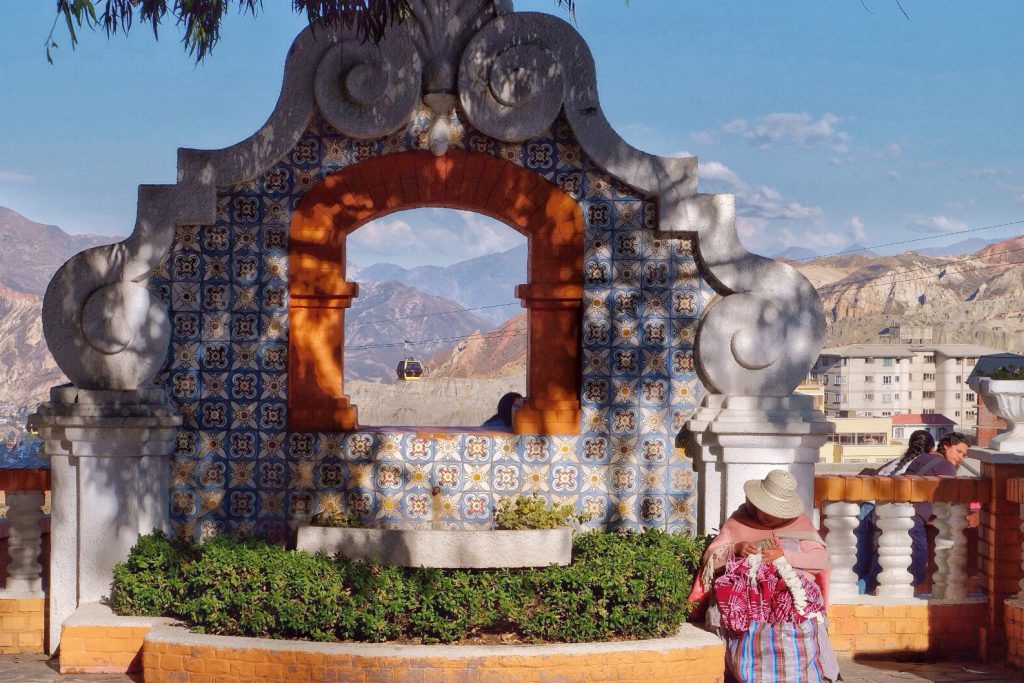
Pretty tiling at Mirador Montículo. Picture by Giacomo Russo.
A haven right in the heart of Sopocachi, this park sits on a hill above Plaza España.
The mirador is easily accessible from the Sopocachi yellow Mi Teleferico stop or Plaza Avaroa.
Downtown La Paz can be viewed from a parade along the crest of the hill.
Smaller, but no less beautiful than other miradors, it is a hidden gem.
Away from the hordes of tourists, spend a peaceful hour resting on the sloping lawns and take in the city below.
Marvel at the beauty of old La Paz
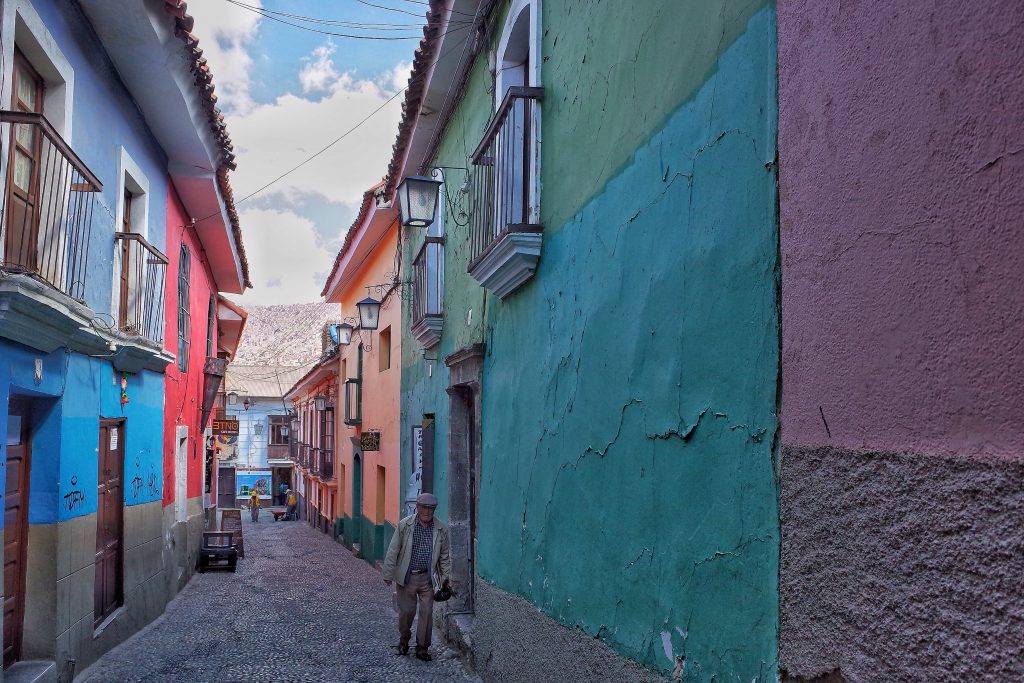
The pastel colours of Jaén street. Picture by Ounie Christianson.
One of the oldest streets in the city, Calle Jaén is a glimpse into La Paz’s colonial past.
This narrow cobbled pedestrian-only street is lined with ancient multi-coloured houses.
The pastel shades of yellow, pink and blue of the facades hide quaint boutiques, museums and art galleries.
While, at weekends the street is filled with live music and entertainment.
Head there to enjoy an ice cold Paceña, the local La Paz beer, in traditional surroundings.
Visit the city’s top museums and explore Bolivia’s culture

Festival masks in the National Museum of Ethnography and Folklore. Picture by Giacomo Russo.
The National Museum of Ethnography and Folklore is housed in an 18th century palace.
It holds a large collection of artefacts celebrating Bolivia’s ethnic diversity.
Go to learn more about Bolivia’s rich culture from the carnival costumes decorated in feathers and traditional weaving in addition to festival masks.
This museum is full of ancient relics, elegantly and accessibly displayed.
Furthermore, English tours are available and the museum plays host to courses in dance and art.
Meanwhile, The Museum of Coca sheds light on the controversial, yet often misunderstood coca leaf.
Consumed by many Bolivians, the coca leaf is sold in every market.
It is an integral part of Bolivian and Andean culture.
The leaves are chewed to ward off altitude sickness.
Another way to enjoy the leaf is to brew it in tea.
This museum explores the history of the leaf from its role in religious ceremonies to use in the production of cocaine.
This is a rather unique and entertaining way to discover Bolivian cultural heritage.
Take a hike in the Valley of the Moon

The Moon Valley in La Paz. Picture by Giacomo Russo.
Valle de la Luna is just a short drive from the city centre and is one of La Paz’s natural phenomenons.
The compact valley is made up of bizarre rock formations that resemble a lunar landscape.
Walk amongst the strange-shaped stones, enjoying the variety of viewpoints and forget for a moment that you are so close the city!
Risk life and limb for an adrenaline rush on the Death Road
Thrill seekers flock to the North Yungas road that connects La Paz to Corioco, an hour northwest of the city.
Join in the scary fun by cycling down the 64km stretch of road dubbed ‘the world’s most dangerous,’ through gorgeous scenery of lush green rainforest that blankets the mountains on all sides.
La Paz Travel Guide – Where to eat
Gustus
Delight your tastebuds in the restaurant that started a revolution! From the co-creator of the world-famous Noma comes a restaurant that takes Bolivian cuisine to new heights.
Avenida Costanera, Zona Sur
Fellini
Recharge your sightseeing batteries with tasty plates of fresh pasta and deliciously thin pizzas in this Italian-run Zona Sur favourite.
Avenida Montenegro, Zona Sur
Los Qñapes
A cafe whose name derives from the Bolivian lowland baked delicacy made from yucca flour and cheese.
Enjoy the taste sensations of traditional food from the tropical lowlands that this fresh modern cafe offers.
Calle René Moreno, Zona Sur
Cafe MagicK
A cosy hideaway in the heart of Sopocachi.
A great option for vegetarians as it serves up mostly vegetarian and vegan food in addition to fish dishes.
Come of an evening and sit back with a Chuflay, a local cocktail made with Bolivian brandy, lemon and ginger ale.
Presbítero Medina, Sopocachi
Antigua Miami
This cute courtyard cafe right in the centre of town is the perfect spot to enjoy an afternoon coffee and cake. Also order one of the snacks or sandwiches to stave off afternoon hunger pangs.
Calle Murillo, El Prado
La Paz Travel Guide – Where to Shop
The Witches Market El Mercado de Las Brujas
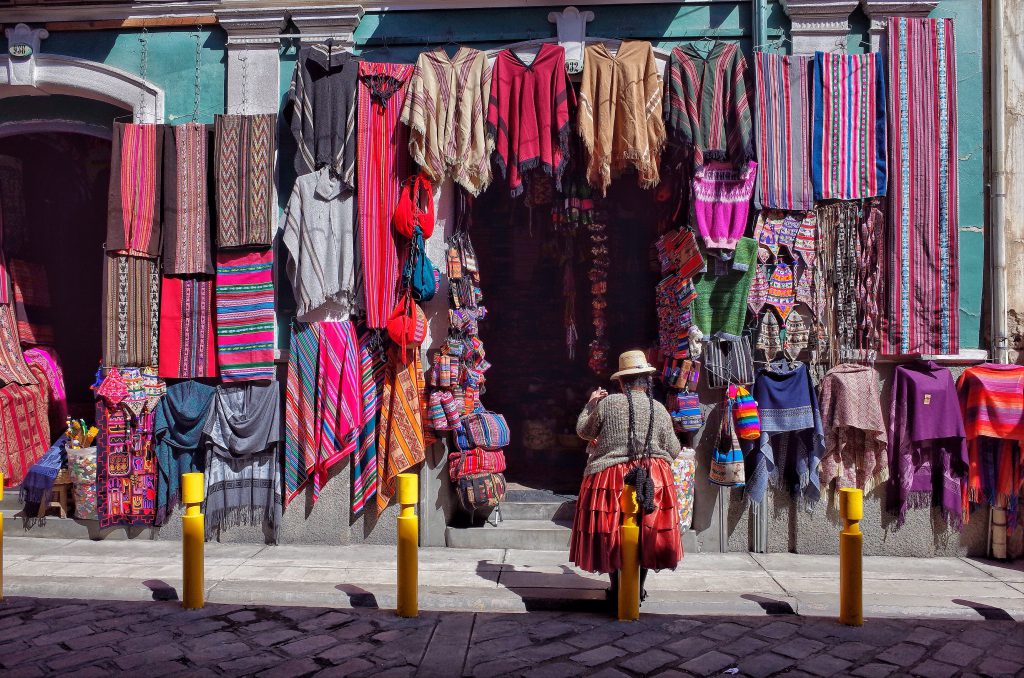
A Craft Shop Near the Witches Market. Picture by Ounie Christianson.
Discover strange delights on the stalls, which local witchdoctors run.
They sell a huge variety of potions, herbs and dried llama foetuses, all for the realisation of ancient rituals.
The Witches Market is also in a part of town with an abundance of craft shops – a real gift-buyers’ paradise!
Mercado Rodriquez
Get lost in the sights, smells and taste of the largest food market in La Paz.
Strolls for hours among the mostly outdoor stands discovering all the produce Bolivia has to offer.
There also cheap comedors – eating places where you can savour traditional dishes for a few Bolivianos.
Zona Sur
The area of San Miguel in Zona Sur has something for everyone.
A delectable array of shops around Avenida Montenegro range from craft boutiques to art galleries, interior design shops and international fashion stores.
As you can see from our La Paz Travel Guide there are so many great reasons to discover Bolivia’s intriguing capital city.
Contact us for more information, or to customise your unique Bolivian tour.
La Paz Travel Guide – About La Paz
Population: nearly 800,000
Currency: Boliviano
Altitude: 3640 metres (11,900 feet)
La Paz Travel Guide FAQs
Is La Paz safe for tourists?
Like any big city, it depends where you go and how you carry yourself.
La Paz isn’t dangerous, but it’s not Disneyland either. Stay alert in crowded areas, watch your pockets, and take registered taxis at night. Use street smarts — not paranoia — and you’ll be just fine.
How high is La Paz, and will I feel the altitude?
La Paz sits at a lung-crushing 3,640 meters (11,942 ft).
Yes, you’ll feel it — maybe with headaches, short breath, or fatigue. Take it slow on day one. Coca tea helps. So does water, rest, and humility. Altitude doesn’t care how fit you are.
What are the best things to do in La Paz?
Start with the Mi Teleférico cable cars — a surreal way to explore the city from the sky. Visit the Witches’ Market, hike the Valley of the Moon, watch Cholita wrestling, and if you’ve got nerve, bike down Death Road. This city doesn’t run out of stories.
How do I get around La Paz?
Cable cars are king here — cheap, efficient, and scenic.
Minibuses are everywhere but confusing to outsiders. Uber works. Walking is doable, but prepare for steep climbs and thin air. The city moves fast — learn to dance with its rhythm.
Is La Paz worth visiting compared to other cities in Bolivia?
If you’re after bland, polished and predictable — maybe not.
But if you want raw culture, altitude-induced clarity, and a city that feels something — La Paz delivers. It’s chaotic, layered, sometimes overwhelming, always unforgettable.
What should I pack for La Paz?
Think layers. Mornings are cold, afternoons sunny, nights freezing.
Bring a warm jacket, sunblock, good shoes, and anything that helps with altitude. Leave space in your bag — La Paz’s markets will tempt you.
Like it? Pin it!
